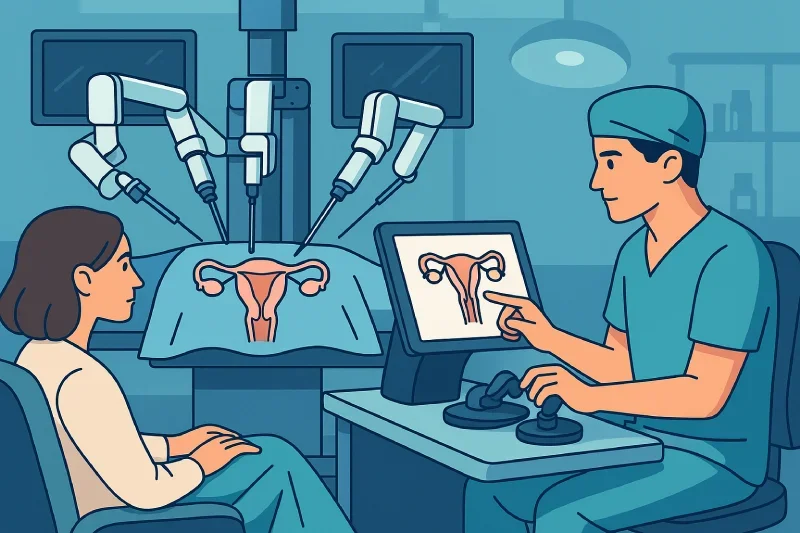What Are the Disadvantages of Tubal Reversal in Burleson, TX?
Categories:
By: Ethan Cole
For many women and couples who previously chose tubal ligation as a form of birth control, a change in life circumstances can lead them to revisit their reproductive goals. What are the disadvantages of tubal reversal in Burleson, TX? This is a common question for those considering restoring fertility. While tubal reversal can reconnect the fallopian tubes and offer the chance to conceive naturally, it’s important to understand the potential challenges, including surgical risks, ectopic pregnancy, and variable success rates.
Tubal Reversal
The tubal reversal process, also called tubal ligation reversal or reversal surgery, involves repairing or reconnecting the Fallopian tube segments that were ligated or surgically removed during tubal ligation. A tubal reversal surgery typically uses microsurgical techniques to achieve the highest possible success rates. However, this reversal procedure requires an incision, general anesthesia, and can be performed as an outpatient or inpatient surgical procedure depending on the complexity of the reconstruction of the fallopian tubes.
Fertility and IVF
Restoring tubal patency after tubal sterilization is only one part of achieving pregnancy. Infertility factors like low sperm count, diminished ovarian reserve, or uterine anomalies might still hamper efforts to conceive. In such cases, IVF (in vitro fertilization) serves as a valuable alternative. During IVF attempts, fertility surgeons retrieve mature eggs and combine them with sperm from the woman’s partner, a partner or a sperm donor, or a woman’s partner or a sperm bank, allowing embryos that develop to be transferred to the uterus.
Fertility Treatment
When deciding between tubal reversal or IVF, you must consider various fertility treatment options based on egg retrieval possibilities and the forecasted pregnancy rate. For instance, consider IVF if your fallopian tube length is insufficient for reversal of tubal ligation, or if you have additional infertility issues. Each effective fertility treatment differs in cost, invasiveness, and pregnancy success rates, so counseling patients thoroughly is key.
Tubal Ligation
Tubal ligation is a method of tubal sterilization often done through laparoscopy or a mini-laparotomy. Surgeons sometimes use the Da Vinci Surgical System for minimally invasive approaches. During tubal ligation surgery, portions of the tubes are ligated or surgically removed, preventing sperm from meeting the egg. If you regret this form of birth control, you can look into a tubal reversal procedure or alternative to tubal reversal like IVF.
Worth Fertility
At Worth Fertility and various fertility center locations, fertility specialists and Austin fertility surgeons offer expert guidance. They evaluate whether a successful tubal reversal procedure is feasible by assessing how much of the portion of the tube remains, as well as your ovarian reserve and overall health. If tubal reversal can be costly or not recommended, exploring rates with IVF might be the next step in your journey.
Process of IVF
The process of IVF typically involves ovarian stimulation so that multiple eggs are mature at once. Following an egg retrieval procedure, the eggs are combined with sperm in a lab setting to create embryos that develop. Next, the fertility team will prepare her uterine lining for implantation. During embryo transfer, they may transfer one healthy embryo or more, based on your IVF attempts and counseling patients guidelines. This method of tubal bypasses the fallopian tube entirely, making it an alternative to tubal reversal that avoids incision is made in the abdomen.
Sperm and Embryo Considerations
Whether you opt for tubal reversal surgery or IVF, healthy sperm is crucial for fertilization. During in vitro fertilization, sperm from the woman’s partner or partner or a sperm donor can fertilize the extracted eggs. A resulting embryo must be genetically viable, and embryo transfer success depends on factors such as age, reproductive history, and general health.
Vitro Fertilization
Vitro fertilization is often favored by those who face difficulties with tubal patency or want quicker pregnancy success rates. When comparing tubal reversal and in vitro or tubal reversal or ivf, reversal and in vitro fertilization can both lead to conception, though each has different timelines, higher pregnancy rates or lower success likelihood, and specific risks associated. Some patients who undergo IVF see higher pregnancy chances if the uterus remains receptive.
Tubal Sterilization and Microsurgical Options
Tubal sterilization via microsurgical approaches like laparotomy or mini-laparotomy can reduce healing time, yet a tubal ligation surgery may involve scarring that impacts a future reversal surgery. Microsurgical suturing during the reconstruction of the fallopian tubes aims to maintain blood supply and tubal patency. Yet, there is always a possibility of ectopic pregnancy after tubal reversal procedure despite the best microsurgical techniques.
Tubal Reversal and In Vitro
Weighing tubal reversal and in vitro means evaluating time, cost, and success variables. A successful tubal reversal procedure could allow you to conceive multiple children naturally if your fallopian tube remains functional. However, IVF can streamline attempts to conceive and potentially boost pregnancy rate if age or other infertility factors are present.
Reversal and In Vitro Fertilization
Both reversal and in vitro fertilization have pros and cons. IVF might be more expensive in some cases but can bypass damaged tubes entirely. On the other hand, a tubal ligation reversal is a surgical procedure that allows future natural pregnancies once tubal patency is restored. Each path requires an informed conversation with fertility specialists.
Fertility Specialists
Fertility specialists and Austin fertility surgeons assess your medical history, current health, and life circumstances. They can perform a hysterosalpingogram to evaluate your tubes and help you decide whether a tubal reversal can be costly compared to IVF attempts. If surgery is deemed beneficial, you may have a recovery period of one to two weeks before you can return to work.
Alternative to Tubal Reversal
Alternative to tubal reversal procedures include relying on IVF instead of repairing the ends of the fallopian tubes. This approach often suits women who have limited remaining tube length or who prioritize faster pregnancy success. Additionally, women looking to conceive at an older age may still achieve higher pregnancy rates with IVF and egg retrieval techniques, bypassing the tubes altogether.
Embryo Transfer
After egg retrieval procedure, an embryo transfer is done to place the fertilized embryo into the uterine cavity. If IVF is successful, implantation occurs in the uterus, leading to potential pregnancy. This step proves especially valuable for women whose tubal reversal did not restore tubal patency or whose tubal ligation reversal comes with complications.
Risks Associated
The risks associated with tubal reversal or IVF vary. Ectopic pregnancy is a concern following reversal procedure, while IVF carries risks of ovarian hyperstimulation or multiple gestations, especially if more than transfer one healthy embryo is chosen. Additionally, tubal reversal can be costly, and neither option guarantees pregnancy success. Weighing these factors with a knowledgeable care team is crucial.
Ready to explore your fertility options? Let’s discuss the best path for you.
Call (817) 568-8731Categories:
Frequently Asked Questions
-
While tubal reversal can restore fertility for many women, it comes with some disadvantages that should be carefully weighed. These include the risks associated with any surgical procedure, such as infection, bleeding, or scarring. Additionally, ectopic pregnancy—where the fertilized egg implants outside the uterus—occurs more frequently after tubal reversal. Success rates can vary depending on factors like age, fallopian tube length, and overall reproductive health. In some cases, IVF may offer a more predictable path to pregnancy without the need for surgery.
-
Most fertility specialists recommend waiting at least one menstrual cycle to allow initial healing before trying to conceive. However, every patient differs in recovery time. Doctors may advise additional imaging or a hysterosalpingogram to confirm good tubal patency. Discuss a tailored timeline with your surgeon to ensure the best chance of pregnancy success.
-
While many tubal reversal procedures require general anesthesia, some surgeons may discuss sedation or regional blocks for certain cases. The method chosen depends on clinical factors such as your health history, the surgical technique planned, and any pre-existing conditions. Always talk with your medical team about comfort measures well before surgery.
-
Low sperm count can significantly affect natural conception chances, even after a successful tubal reversal procedure. In such situations, IVF or intrauterine insemination (IUI) might be recommended. Fertility specialists may suggest lifestyle changes, medications, or advanced reproductive technologies that help mitigate low sperm count issues and improve pregnancy rates.
-
Yes. If the reconstructed tubes fail to maintain patency or if you encounter recurrent ectopic pregnancy, IVF remains a strong option. IVF bypasses the fallopian tubes entirely, reducing the chance of another ectopic. Discussing backup plans with your surgeon before initiating tubal reversal surgery ensures you’re prepared for alternative approaches.
-
da Vinci robotic-assisted procedures can offer greater precision and reduced downtime, but not every patient qualifies. Factors like the length of remaining tubes, scarring risk, and overall reproductive health play a role. A fertility surgeon specializing in robotic methods can assess whether you’re a good fit for this microsurgical technique.
-
Balanced nutrition, regular exercise, and maintaining a healthy weight can support your reproductive system following tubal reversal. Avoiding smoking, reducing alcohol intake, and managing stress also benefit pregnancy rates. Your surgical team may recommend specific vitamins, supplements, or follow-up tests to optimize your physical fitness and improve your chances of carrying a healthy pregnancy.
-
Success depends on the extent of tubal damage, your surgeon’s expertise, and the surgical method used. In many cases, both tubes can be reconnected, but sometimes only one tube is salvageable. Age, scarring from the initial sterilization, or additional reproductive conditions can also influence how many tubes can be fully repaired.
-
A hysterosalpingogram (HSG) is often used after tubal reversal to check for tubal patency. This specialized X-ray test involves injecting dye into the uterus to see if it passes through the reconnected tubes. An HSG can help identify any blockages or leaks, guiding further decisions about fertility treatments or IVF attempts if needed.
-
Yes, counseling patients on family planning is essential. A successful tubal reversal procedure might change your reproductive timeline, especially if you conceive sooner or more frequently than expected. Talking with fertility specialists about long-term planning ensures you remain informed about potential subsequent pregnancies, contraceptive options, and ongoing fertility health.













